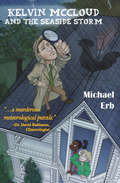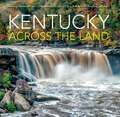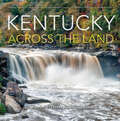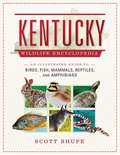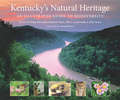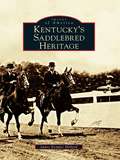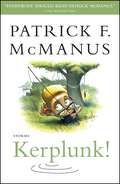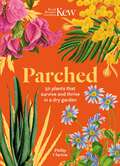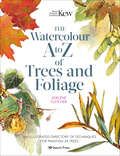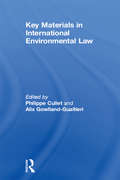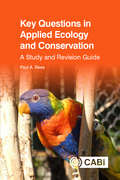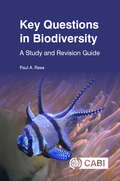- Table View
- List View
Kelly of Hazel Ridge (Hazel Ridge Farm Story #3)
by Robbyn Smith van FrankenhuyzenAs a young girl growing up on Hazel Ridge Farm, Kelly knows her home is unique. After all, not everyone has a backyard where white-tailed deer and sandhill cranes wander freely. Here Kelly can help nurse a fawn back to health, swim in ponds where snapping turtles lurk, or even drift off to sleep each night to the hoot of an owl named Jackson. At Hazel Ridge Farm Kelly's parents have created a wildlife sanctuary where both the land and its residents (animal as well as human) are nurtured and can live in harmony. Kelly of Hazel Ridge is the third title in the Hazel Ridge Farm series by husband-and-wife team Gijsbert and Robbyn van Frankenhuyzen, and is inspired by life on their 40-acre farm located in Bath, Michigan. For over 20 years Robbyn and Gijsbert (also known as Nick) have nurtured the land back to health, and raised and released injured and orphaned animals.
Kelvin McCloud and the Seaside Storm
by Michael ErbAn anonymous note in the middle of the night, an obituary for a banker who died in a hailstorm, and a mysterious woman vanishing down the stairwell: these clues lead Henry Alabaster and his uncle Kelvin McCloud to a spooky mansion in a coastal town. As a weather detective, Kelvin knows a thing or two about hailstorms, and then strange events surrounding the banker's death suggest foul play. Henry teams up with the fiery, artistic Rachel to help his uncle investigate, and they learn a lot about weather on the way. Nothing--not a thunderstorm, threats, burglary, a baseball bat-wielding suspect, nor even a devastating fire--can keep Henry and his team from chasing down the truth.
Kennzahlen zur Erreichung der weltweiten Klimaziele: Band II: Amerika, Nahost und Südasien, Ostasien und Ozeanien
by Valentin CrastanAnalysiert werden die aktuellen Kennzahlen aus der Energiewirtschaft für die geographischen Einheiten Amerika – unterteilt in Nordamerika (Kanada + USA) sowie Mittel- und Südamerika –, Nahost und Südasien sowie Ostasien und Ozeanien. Die wichtigsten energiewirtschaftlichen Indikatoren der einzelnen Regionen und Länder und deren Entwicklung werden in zahlreichen Grafiken und Energieflussdiagrammen veranschaulicht. Darauf basierend empfiehlt der Autor eine Verteilung der zur Begrenzung des Klimawandels notwendigen Emissionsreduktion (für Klimaziel 2 °C und 1,5 °C, mit Perspektive bis 2050).Die in diesem Band behandelten Erdteile verursachen zusammen 77 % der Emissionen. Europa + Eurasien sowie Afrika werden in einem weiteren Band behandelt.
Kentucky Across the Land
by Lee Mandrell DeeDee Niederhouse-MandrellTransport yourself to the Bluegrass State with this photographic tribute to iconic spots from Mammoth Cave National Park to Buffalo Trace Distillery.Known for its rolling hills, scenic Thoroughbred farms, and renowned state parks, Kentucky offers enjoyment for those seeking stunning landscapes, natural wonders, small town charms, and bourbon country adventures. Follow photographers Lee Mandrell and DeeDee Niederhouse-Mandrell on a visual journey across the Bluegrass State, as they travel from Cumberland Falls State Resort Park to Mammoth Cave and National Bridge National Parks, showcasing the exquisite scenery and natural heritage along the way.Featuring more than 130 breathtaking photos, Kentucky Across the Land inspires travelers to take their own journeys to explore the history at the Lincoln Homestead State Resort Park, the untouched natural beauty of Red River Gorge and Land Between the Lakes, or the picturesque cascades along Flat Lick Creek at Flat Lick Falls.
Kentucky Across the Land
by Lee Mandrell DeeDee Niederhouse-MandrellTransport yourself to the Bluegrass State with this photographic tribute to iconic spots from Mammoth Cave National Park to Buffalo Trace Distillery.Known for its rolling hills, scenic Thoroughbred farms, and renowned state parks, Kentucky offers enjoyment for those seeking stunning landscapes, natural wonders, small town charms, and bourbon country adventures. Follow photographers Lee Mandrell and DeeDee Niederhouse-Mandrell on a visual journey across the Bluegrass State, as they travel from Cumberland Falls State Resort Park to Mammoth Cave and National Bridge National Parks, showcasing the exquisite scenery and natural heritage along the way.Featuring more than 130 breathtaking photos, Kentucky Across the Land inspires travelers to take their own journeys to explore the history at the Lincoln Homestead State Resort Park, the untouched natural beauty of Red River Gorge and Land Between the Lakes, or the picturesque cascades along Flat Lick Creek at Flat Lick Falls.
Kentucky Wildlife Encyclopedia: An Illustrated Guide to Birds, Fish, Mammals, Reptiles, and Amphibians
by Scott ShupeFrom the earliest European exploration and settlement of Kentucky, the state’s wildlife has played an important role. Men like the legendary Daniel Boone were in part lured to Kentucky by the opportunity to hunt Whitetail Deer, Bison, and Elk; and the Native Americans living in the region sustained themselves largely by harvesting mammals, birds, and fish. While the state’s wildlife is still an important resource for trappers, hunters, and fishermen, wildlife is also increasingly important for its intrinsic, aesthetic value. In Kentucky Wildlife Encyclopedia, nationally known naturalist Scott Shupe has collected information on all the wildlife that reside in the Bluegrass State. The first in a series of state wildlife encyclopedias, this book will be a handy, usable, layman’s guide to Kentucky’s wildlife. Included are over 800 color photographs, depicting the different species of mammals, reptiles, amphibians, birds, and fish, while also offering over 600 range maps to show their territory. Along with basic information for the biology of each animal, Shupe includes the size, habitat, and abundance of each species located in the state. Whether you’re a lover of the outdoors, photography, or are looking to learn more about your state, this comprehensive guide will teach you about the wonderful wildlife that covers the water, earth, and skies of Kentucky.
Kentucky's Natural Heritage: An Illustrated Guide to Biodiversity
by Deborah White Greg Abernathy Ellis L. Laudermilk Marc Evans“[A] beautiful book about a state that has just about everything except a beach: mountains, swamps, rivers, plains, and, of course, the lovely bluegrass.” —Baton Rouge AdvocateKentucky’s abundance of plant and animal life, from the bottomland swamps in the west to the rich Appalachian forests in the east, is extraordinary as well as beautiful. Glades, prairies, forests, wetlands, rivers, and caves form a biologically diverse patchwork that is unique to the state. Kentucky’s Natural Heritage: An Illustrated Guide to Biodiversity provides an essential reference to the remarkable natural history of the commonwealth and is a rallying call for the conservation of this priceless legacy.Kentucky’s ecosystems teem with diverse native species, some of which are found nowhere else in the world. Kentucky’s Natural Heritage brings these sometimes elusive creatures into close view, from black-throated green warblers to lizard skin liverworts. The aquatic systems of the state are home to rainbow darters, ghost crayfish, salamander mussels, and an impressive array of other species that constitute some of the greatest levels of freshwater diversity on the planet.Richly detailed and lavishly illustrated with more than 250 color photos, maps, and charts, Kentucky’s Natural Heritage is the definitive compendium of the commonwealth’s amazing diversity and presents a persuasive argument for the necessity of conservation. Organized by a team from the Kentucky State Nature Preserves Commission, the book is an outgrowth of the agency’s focus on biodiversity protection.“Between its covers, readers will find details of Kentucky’s vanished natural areas and catalogue of the increasingly rare animal, plants and unique habitats that urgently need protection.” —Louisville Courier Journal
Kentucky's Saddlebred Heritage (Images of America)
by James Kemper MillardLong associated with fine Thoroughbred horses, Kentucky's Bluegrass region is also home to America's oldest indigenous breed: the American Saddlebred horse. A composite of several breeds, the Saddlebred was developed by 18thcentury colonists who sought a goodlooking, sensible, adaptable, and comfortable animal to ride and drive. These traits made it the mainstay of the Confederate cavalry during the Civil War and the choice mount of many generals on both sides. As the Industrial Revolution replaced the need for working horse power, the Saddlebred evolved naturally into recreational activities. Affectionately known as "peacock of the show ring," the Saddlebred's beauty, expression, and athleticism epitomize the essence of a show horse. In many ways, the breed's history parallels that of America and unfolds in pictures in Kentucky's Saddlebred Heritage.
Kenya: A View Through My Lens
by Hamid Obaid Al AliDive into the heart of Africa’s majestic landscapes and encounter the untamed beauty of Kenya’s wildlife through the lens of Hamid’s captivating photography. From the sweeping savannahs of the Maasai Mara to Amboseli National Park, this stunning collection transports you to the vibrant world of Kenya’s diverse ecosystems. Get up close and personal with iconic species such as elephants, lions, giraffes, and rhinos, as well as lesser-known treasures like the gray-crowned crane and the African fish eagle. With each breathtaking image, immerse yourself in the raw power, grace, and intricate beauty of Kenya’s natural wonders. A visual masterpiece that celebrates the spirit of the African wilderness, this book is a must-have for wildlife enthusiasts, photography aficionados, and armchair travelers alike. Prepare to be spellbound by the splendor of Kenya’s wildlife in this unforgettable journey through the lens.
Kerka’s Book (Fairy Godmother Academy #2)
by Jan BozarthFor girls who are fans of Harry Potter and have outgrown the Disney Fairies series and the American Girl books, the Fairy Godmother Academy is the perfect series-fantasy books filled with magic and adventure but grounded by contemporary girls and issues. The series boasts an amazing Web site that allows girls to enter the world they visit in the books. There they can do activities both on- and offline, vote for things they'd like to see in the books, and connect with other Fairy Godmother Academy fans. Zally Guevara always knows where she's going. She has a passion for maps of all kinds and can't wait to pack her suitcase and explore the world. But Zally doesn't have to wait to get her wish. With the help of a cup of magical cocoa from her grandmother, she travels to a place that only girls training to become fairy godmothers can get to-the enchanted dreamland of Aventurine, a place that has no map. In Aventurine, Zally is given her quest: to save a fairy queen who has lost her will to live. Zally's companions are a young fairy with a broken wing, and a stallion prince. The trio's journey proves to be even more challenging than they could have imagined as they meet monsters and get lost in a ruined fairy city. All the while, Zally is making a map of Aventurine and discovering that she has a talent, passed down from generations of women in her family: understanding the thoughts of animals. But will this be enough to save the fairy queen and ensure that Zally can continue her fairy-godmother training? Join the Fairy Godmother Academy! Visit the Web site for games, activities, and networking with friends! www. fairygodmotheracademy. com
Kerplunk!
by Patrick F. McmanusPatrick F. McManus's gently comic stories about outdoor life have earned him millions of fans worldwide. With Kerplunk!, McManus delivers a collection of folksy, wonderfully wise depictions of country life worthy of Mark Twain. In these tall tales, McManus and his buddies learn how not to net a fish, why you should never get your hair cut by someone who's mad at you, what to do when a deer wanders into camp but your sleeping bag has frozen shut, and how to avoid bird-dog flatulence. Traveling the highways and byways of the Pacific Northwest, the delightful backcountry characters of Kerplunk! understand how a life of hunting and fishing -- and its inherent potential for misadventure -- can resonate with larger meaning. McManus's characters know exactly why it costs $500 to make a fly lure that retails for $2; why installing a boat trailer hookup can lead to divorce; and, most important, why you should always listen for the sound of your fishing line hitting the water -- because in life as it is in fishing, you don't know you're in the water until you hear the kerplunk! These wry, curmudgeonly tales appeal to real outdoorsmen and the armchair variety alike. Often nostalgic, occasionally philosophical, and always funny, the stories in Kerplunk! reaffirm Patrick F. McManus's reputation as an American classic.
Kew - Parched: 50 plants that thrive and survive in a dry garden
by Philip ClaytonDazzling, diverse, durable - discover the remarkable drought-proof plants that flourish in the driest environments.With rainfall unpredictable and summers increasingly hot, plants that survive and thrive in these conditions have become more important than ever. Through expert text and beautiful botanical illustrations from the archives of the Royal Botanic Gardens, Kew, Parched explores the captivating variety that exists in the world of dry plants. From poppies and palms to cypress and cyclamen, this stunning book showcases the incredible species that have become a mainstay of dry gardens around the world.
Kew - Parched: 50 plants that thrive and survive in a dry garden
by Philip ClaytonDazzling, diverse, durable - discover the remarkable drought-proof plants that flourish in the driest environments.With rainfall unpredictable and summers increasingly hot, plants that survive and thrive in these conditions have become more important than ever. Through expert text and beautiful botanical illustrations from the archives of the Royal Botanic Gardens, Kew, Parched explores the captivating variety that exists in the world of dry plants. From poppies and palms to cypress and cyclamen, this stunning book showcases the incredible species that have become a mainstay of dry gardens around the world.
Kew - Rare Plants: The world's unusual and endangered plants
by Royal Botanic Kew Ed Ikin"Some plants are inherently rare, while others become rare through our actions."Rare Plants explores what makes the world's most uncommon plants so exceptional, and by what means they have become so scarce. From highlands to jungles, many of our most extraordinary plants are vanishing at shocking rates, and this exquisitely illustrated book explores 40 of these mysterious species.Featuring stunning archive images and expert insight from the Royal Botanical Gardens, Kew, Rare Plants explores both the beauty and necessity of our endangered plant life.
Kew - Rare Plants: The world's unusual and endangered plants
by Royal Botanic Kew Ed Ikin"Some plants are inherently rare, while others become rare through our actions."Rare Plants explores what makes the world's most uncommon plants so exceptional, and by what means they have become so scarce. From highlands to jungles, many of our most extraordinary plants are vanishing at shocking rates, and this exquisitely illustrated book explores 40 of these mysterious species.Featuring stunning archive images and expert insight from the Royal Botanical Gardens, Kew, Rare Plants explores both the beauty and necessity of our endangered plant life.
Kew - Witch's Forest: Trees in magic, folklore and traditional remedies
by Sandra Lawrence Royal Botanic KewThere is more folklore, mythology and magic associated with our trees and forests than with any other living things.Known throughout the world as dark and wild places where witches make mischief and eerie creatures dwell, forests are also places of sanctuary for the ancient magic and the most enchanting species of trees.Kew: Witch's Forest is a beautifully illustrated, captivating journey through the magical woodland and its stories, from birch broomsticks and the sacred olive, to alder doorways and the Tree of Life.
Kew - Witch's Forest: Trees in magic, folklore and traditional remedies
by Sandra Lawrence Royal Botanic KewThere is more folklore, mythology and magic associated with our trees and forests than with any other living things.Known throughout the world as dark and wild places where witches make mischief and eerie creatures dwell, forests are also places of sanctuary for the ancient magic and the most enchanting species of trees.Kew: Witch's Forest is a beautifully illustrated, captivating journey through the magical woodland and its stories, from birch broomsticks and the sacred olive, to alder doorways and the Tree of Life.
Kew: An Illustrated Directory of Techniques for Painting 24 Trees
by Adelene FletcherTrees have inspired artists for generations. This unique watercolour artist's guide offers easy-to-follow, plant-specific information on how to paint a wonderful selection of the most popular species of trees. Beginning with a useful section on materials, the book then comprises an illustrated directory of 24 trees, from Acer to Zelkova. Step-by-step sequences show how to paint each one in a fresh, lively style with all the essential details of shape and form beautifully captured. The author explores the overall shapes and masses of branches and leaves, outlines in full foliage, winter trees, branch and twig details, and presents stunning leaf and flower portraits shimmering with life. A source of inspiration, as well as a manual of techniques, this book is a must-have for every tree painter. Purchase of this book supports the vital work of Kew – saving plants and fungi around the world that might one day save us.
Kew: Mind-altering plants in folklore, superstition and popular culture (Royal Botanic Gardens, Kew)
by Sandra LawrenceThe ancient Aztecs, the cannabis-smoking farmers of Neolithic China and the Woodstock hippies. Psychoactive plants have been used by different cultures for thousands of years for everything from shamanic rituals to staying awake.From the Royal Botanic Gardens, Kew and Sandra Lawrence, Psychedelics is a fascinating exploration of the mind-altering plants that for centuries have helped shape the way we see the world. Packed with expert text and stunning botanical illustrations from the Kew archive, this book delves into the folklore, cultural relevance and botanical background of remarkable plants that have long been leveraged to hallucinogenic effect.A gorgeous gifty package, this book is both a beautifully illustrated botanical history and quirky cultural reference for plant lovers everywhere.
Kew: Mind-altering plants in folklore, superstition and popular culture (Royal Botanic Gardens, Kew)
by Sandra LawrenceThe ancient Aztecs, the cannabis-smoking farmers of Neolithic China and the Woodstock hippies. Psychoactive plants have been used by different cultures for thousands of years for everything from shamanic rituals to staying awake.From the Royal Botanic Gardens, Kew and Sandra Lawrence, Psychedelics is a fascinating exploration of the mind-altering plants that for centuries have helped shape the way we see the world. Packed with expert text and stunning botanical illustrations from the Kew archive, this book delves into the folklore, cultural relevance and botanical background of remarkable plants that have long been leveraged to hallucinogenic effect.A gorgeous gifty package, this book is both a beautifully illustrated botanical history and quirky cultural reference for plant lovers everywhere.
Kew: The science and mythology of medicinal plants (Royal Botanic Gardens, Kew)
by Emma WaylandFor centuries we have harnessed the ancient wisdom of botanical healing, with plants used for a multitude of remedies that nurture both body and soul.Kew: The Apothecary's Garden is a fascinating exploration of nature's pharmacy and the healing power of plants, from soothing hops, chamomile and valerian, and invigorating guarana, maca and ginseng, to the infection-fighting turmeric and tea tree and the immunity-boosting turkey tail mushroom. Herbal remedies, natural tinctures, and the historical and botanical background of plants are revealed through expert text and beautiful illustrations from the renowned Kew archive.This curious history of plants that heal describes the incredible properties of over 60 species. Exploring the original folk remedies they inspired and the science behind them, this is the weird and wonderful story of how humans have harnessed nature's apothecary.
Kew: The science and mythology of medicinal plants (Royal Botanic Gardens, Kew)
by Emma WaylandFor centuries we have harnessed the ancient wisdom of botanical healing, with plants used for a multitude of remedies that nurture both body and soul.Kew: The Apothecary's Garden is a fascinating exploration of nature's pharmacy and the healing power of plants, from soothing hops, chamomile and valerian, and invigorating guarana, maca and ginseng, to the infection-fighting turmeric and tea tree and the immunity-boosting turkey tail mushroom. Herbal remedies, natural tinctures, and the historical and botanical background of plants are revealed through expert text and beautiful illustrations from the renowned Kew archive.This curious history of plants that heal describes the incredible properties of over 60 species. Exploring the original folk remedies they inspired and the science behind them, this is the weird and wonderful story of how humans have harnessed nature's apothecary.
Key Materials in International Environmental Law
by Alix Gowlland-GualtieriThis compilation of key materials in international environmental law takes account of the most significant developments in the field that have occurred during the past decade, including in the areas of climate change, chemicals and pesticides, biosafety, and nuclear safety, as well as good governance, compliance and liability. Not only does multilateral environmental law making have wide-ranging repercussions on the way national development policies are drafted and business is conducted, but also environmental issues increasingly interweave with those relating to human rights, trade, agriculture and intellectual property, making familiarity with the key instruments in international law essential for all working in these areas. The book comprises a representative selection of the most important studies in international environmental law, with an editorial introduction to each topic. Its focus on recent trends and cross-sectoral aspects makes it an indispensable tool for students, researchers, practitioners and policy makers in international environmental law and related fields.
Key Questions in Applied Ecology and Conservation: A Study and Revision Guide (Key Questions)
by Dr Paul ReesAn understanding of applied ecology and conservation is an important requirement of a wide range of programmes of study including applied biology, ecology, environmental science and wildlife conservation. This book is a study and revision guide for students following such programmes. It contains 600 multiple-choice questions (and answers) set at three levels - foundation, intermediate and advanced - and grouped into 10 major topic areas: History and foundations of applied ecology and conservation Environmental pollution and perturbations Wildlife and conservation biology Restoration biology and habitat management Agriculture, forestry and fisheries management Pest, weed and disease management Urban ecology and waste management Global environmental change Environmental and wildlife law and policy Environmental assessment, monitoring and modelling The book has been produced in a convenient format so that it can be used at any time in any place. It allows the reader to learn and revise the meaning of terms used in applied ecology and conservation, study the effects of pollution on ecosystems, the management, conservation and restoration of wildlife populations and habitats, urban ecology, global environmental change, environment law and much more. The structure of the book allows the study of one topic area at a time, progressing through simple questions to those that are more demanding. Many of the questions require students to use their knowledge to interpret information provided in the form of graphs, data or photographs.
Key Questions in Biodiversity: A Study and Revision Guide (Key Questions)
by Dr Paul ReesAn understanding of biodiversity is an important requirement of a wide range of programmes of study including biology, zoology, wildlife conservation and environmental science. This book is a study and revision guide for students following such programmes in which biodiversity is an important component. It contains 600 multiple-choice questions (and answers) set at three levels - foundation, intermediate and advanced - and grouped into 10 major topic areas: 1. Principles of classification and taxonomy 2. Comparative anatomy and physiology 3. Protoctists, monerans, fungi, lichens and acellular organisms 4. 'Lower' plants and pteridophytes 5. Seed-bearing plants 6. Sponges, cnidarians, nematodes and minor animal phyla 7. Platyhelminths, annelids and molluscs 8. Arthropods and echinoderms 9. Fishes, amphibians and reptiles 10. Birds and mammals The book has been produced in a convenient format so that it can be used at any time in any place. It allows the reader to learn and revise the meaning of terms used in animal and plant classification, the principles of comparative physiology, and the characteristics of, and diversity in, the major animal and plant taxa. The structure of the book allows the study of one topic area or group of taxa at a time, progressing through simple questions to those that are more demanding. Many of the questions require students to use their knowledge to identify organisms and biological structures from drawings or photographs.

